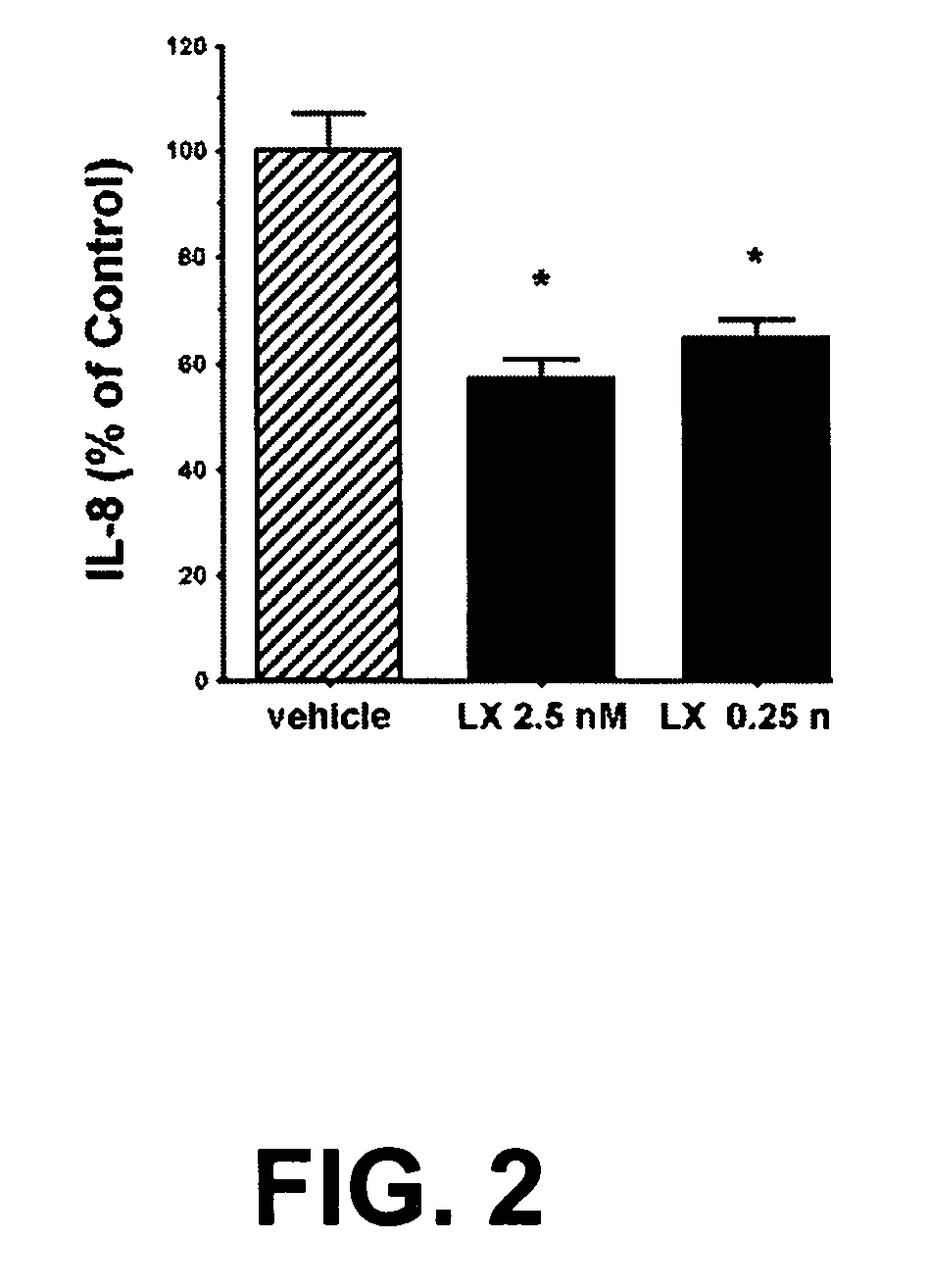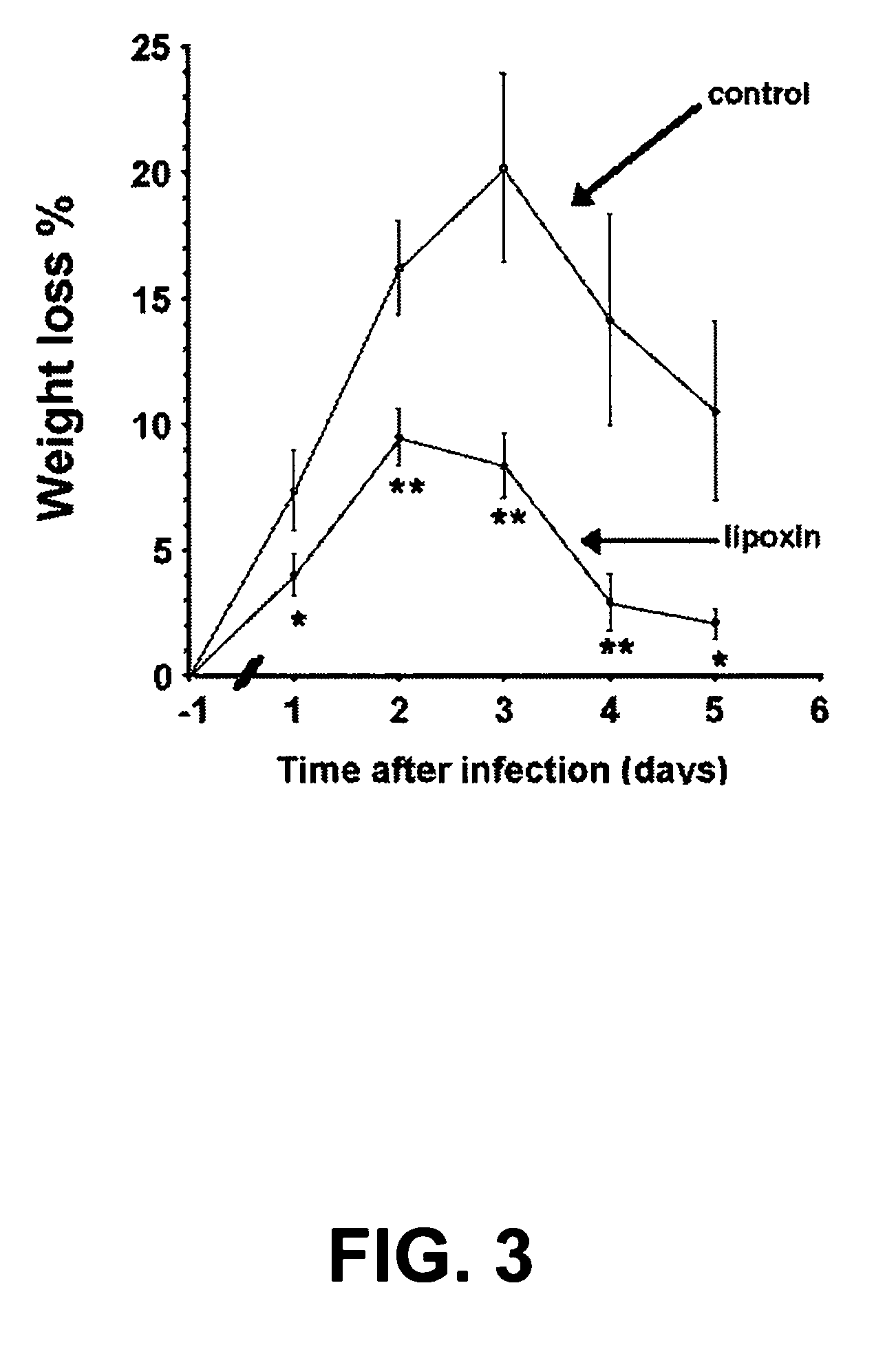Modulation of airway inflammation in patients with cystic fibrosis and related diseases
a cystic fibrosis and cystic fibrosis technology, applied in the field of modulation of cystic fibrosis and related diseases airway inflammation in patients, can solve the problem that the optimal protective response of vigorous neutrophilic inflammation is not optimal, and achieve the effect of treating, preventing, and modulating neutrophilic airway inflammatory responses
- Summary
- Abstract
- Description
- Claims
- Application Information
AI Technical Summary
Benefits of technology
Problems solved by technology
Method used
Image
Examples
example 1
Preparation of 11-dehydro-15-epi-16-(p-fluorophenoxy) LXA4 methyl ester
[0139]
[0140] Part 1: Ooxalyl chloride (0.47 mL, 5.4 mmol) was added dropwise at −78° C. to a solution of dimethyl sulfoxide (0.56 mL, 7.20 mmol) in CH2Cl2 (9 mL) and the solution was stirred at that temperature for 15 min. (5S, 6R) Methyl 5,6-di(tert-butyldimethylsiloxy)-7-hydroxyheptanoate (1,516 mg, 3.60 mmol) in CH2Cl2 (9 mL) was added with the help of a double-end needle and the solution was stirred an additional 45 min. at −78° C. At this point, triethylamine (2.5 mL, 18 mmol) was added slowly to the clowdy white mixture, resulting in the formation of a white solid. The mixture was allowed to reach 25° C. and it was then poured into water and extracted with ethyl acetate. The combined extracts were washed with brine, dried over Na2SO4 and the solvent was evaporated. Flash column chromatography (silica, 5% ethyl acetate / hexanes) afforded pure (5S, 6R) methyl 5,6-di(tert-butyldimethylsiloxy)-7-oxoheptanoate a...
example 2
Preparation of 15-epi-16-(p-fluorophenoxy) LXA4 methyl ester
[0145]
[0146] To a solution of 11-dehydro-15-epi-16-(p-fluorophenoxy) LXA4 methyl ester from Example 1 (0.04 mmol) in CH2Cl2 (10 ml) was added Pd-Lindlar catalyst (1.5 mg, 10% by weight), quinoline (15 μl), and the reaction mixture was stirred under the static atmosphere of hydrogen. Samples were collected every 20 minutes and analyzed by HPLC (reverse phase, 25% water / methanol) and the reaction was stopped at 60-70% conversion. The solution was then filtrated over a pad of celite to remove the catalyst, concentrated and the residue was dissolved in MeOH / water and subjected to preparative HPLC chromatography (40% water / MeOH). Finally, removal of the solvent afforded pure (5S, 6R, 15S)-trihydroxy-16-(4-fluorophenoxy)-hexadeca-(7E, 9E, 11Z,13E)-tetraenoic acid methyl ester or 15-epi-16-(p-fluorophenoxy) LXA4 methyl ester, in 50% yield. 1H NMR (500 MHz, C6D6): δ 6.91 (dd, J=14.4 Hz and 9.7 Hz, 1H), 6.81 (m, 2H), 6.66 (dd, J=14...
example 3
LX Levels are Suppressed in Bronchoalveolar Lavage Fluid
[0147] LX levels were significantly suppressed in bronchoalveolar lavage fluid (BALF) from patients with CF compared with appropriate pulmonary inflammatory controls. A study examining LXA4 levels in the CF airway was performed using BALF samples from 20 subjects.
[0148] Bronchoalveolar lavage (BAL) samples were obtained as previously described (Khan, T. Z. et al. Am J Respir Crit Care Med 151, 1075-1082 (1995).) from 20 new pediatric subjects: 12 with CF, 8 with a variety of other pulmonary inflammatory conditions, including pneumonia, interstitial lung disease, and reactive airways disease. Subjects included males and females, from ½ to 19 years of age, receiving diagnostic bronchoscopy and bronchoalveolar lavage. There were no significant differences in age or sex between patient groups.
[0149] IL-8 and LXA4 concentrations were measured by ELISA (from R&D and Oxford Biomedical Res., respectively). Informed consent was obtai...
PUM
| Property | Measurement | Unit |
|---|---|---|
| temperature | aaaaa | aaaaa |
| temperature | aaaaa | aaaaa |
| time | aaaaa | aaaaa |
Abstract
Description
Claims
Application Information
 Login to View More
Login to View More - R&D
- Intellectual Property
- Life Sciences
- Materials
- Tech Scout
- Unparalleled Data Quality
- Higher Quality Content
- 60% Fewer Hallucinations
Browse by: Latest US Patents, China's latest patents, Technical Efficacy Thesaurus, Application Domain, Technology Topic, Popular Technical Reports.
© 2025 PatSnap. All rights reserved.Legal|Privacy policy|Modern Slavery Act Transparency Statement|Sitemap|About US| Contact US: help@patsnap.com



